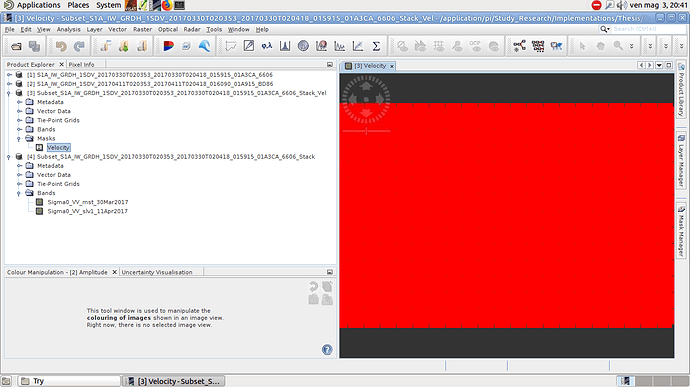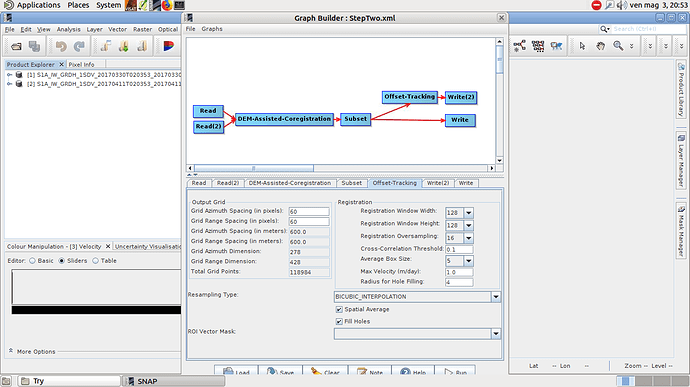It works with all SAR satellites supported by SNAP.
@ABraun Thank you so much for your great guidance
It is possible to make SNAP use your SLC images but the module is designed for GRD in input. Personal tests (Offset Tracking : SLC vs GRDH products) makes me very skeptical about using SLC images in SNAP.
Just for info : The way the module is implemented in SNAP will not allow you to detect very fine displacements. Pixel Offset in SNAP is good for glacier displacement, for sure, but I can’t guaranty it will work for earthquake
I read the tutorial for Offset Tracking using GRDH product of S1 and also, saw the video of RUS service about Glacier Velocity With Sentinel-1. In RUS video, the scientist chose HH polarization for calibration and thermal noise removal steps but my downloaded S1 images have only VV and VH polarizations. So, I am worried about this dataset is suitable to process in this way or not?! 
What is your idea?
It does not really matter if your polarisation over land is VV for HH, but HH is definitely better for glaciers. It will be interesting to see if offset tracking works for (huge) earthquake displacements.
I will try to do this process for three earthquakes and update the results here. I hope to get the reasonable outputs for this step again.
I would say it’s unlikely to work but perhaps you get lucky. I would start with some huge earthquake with multi-metre slip on the surface.
So, if I am failed in using Offset Tracking tool in SNAP, I should make a code to find offsets tracking using S1 SLC images.
The result strongly differs with the settings, maybe you need to increase the window size.
@ABraun Yes. I would like to test this tool with a different suitable setting for earthquake and get the results and see maybe I can get the reasonable ones. I don’t know I only need to try 
At first, I got this result in the following:
I set the parameters like follows. Do you have any suggestion that we can do to maybe get the result?
In case you used SRTM 3Sec for coregistration, try switching to SRTM 1Sec, because problems were lately reported with the first one. When the coregistation fails, the subsequent steps are obsolete. But it is hard to check which step in the graph cause the error. So it would maybe help to prepare the data until “Subset” and make sure it is correct and then apply different settings of the Offset Tracking tool on it.
@ABraun Thank you so much. I am doing your suggestion to check step by step. I need to tell you that I also applied Thermal Noise Removal and Calibration steps before doing this graph based on RUS service webinar. I read the SNAP tutorial and help about these steps and found them useful for GRDH products but I don’t know they are special for glacier environment and application or not?!
@EJFielding Excuse me, I read your suggested papers and also other papers which had used the azimuth offset method to help them for 3-D displacement generation. I found this method with high RMS and not very accurate measurement. Is it correct? Is it not possible for us to rely on this method for 3-D displacement?
In your paper, I saw that the RMS of the Azimuth offset method is 20 times worse than the RMS of InSAR results  which cannot be good for the earthquakes with less than 1m displacement.
which cannot be good for the earthquakes with less than 1m displacement.
Excuse me, do you have any suggestion of the huge earthquakes to test? I think I was failed in using offset tracking for my considered earthquake
@SMJMirzadeh Yes, the azimuth offset method has much less accuracy than the InSAR phase. The typical accuracy is about 1/10 of the pixel size (sometimes it can be as good as 1/20 of the pixel size). For the 2003 Bam earthquake in Iran, we used the ESA Envisat SAR regular stripmap data. This had an azimuth pixel size of around 4 meters, so we could measure motion of about 0.5 meters. The Copernicus Sentinel-1 TOPS mode has an azimuth pixel size of 14 meters, so you can’t measure motion smaller than about 1.5 meters with azimuth offsets.
The Sentinel-1 azimuth offsets are most useful for earthquakes larger than M 7.5. My colleagues were able to measure the motion of the M7.3 November 2017 Sarpol-e Zahab earthquake with Sentinel-1 azimuth offsets but the signal is close to the noise level. See:
@EJFielding Thank you so much for your great information. I got it very well.
So, for the earthquakes smaller than M 7.5., I need to find another method to 3-D displacement generation. Do you have any idea about using COSI-Corr software developed by Caltech?
I last used the COSI-Corr software some years ago, but I have worked with people who used it recently. It is designed for optical imagery, not SAR imagery, as it supports the geometry of many optical satellites.
You can get approximately the same pixel offset accuracy from optical images, about 1/20 of a pixel. If you can obtain optical images with 1 meter pixels then you can measure displacements as small as 5-10 cm.
My colleague used optical images from Planet Labs satellites to measure displacements from the 2018 Mw 7.5 Palu earthquake in Indonesia. Those satellites have pixel sizes of about 3 meters, so you can measure about 30-60 cm of displacement. See:
https://www.nature.com/articles/s41561-018-0297-z
@EJFielding Thank you in advance for your nice information.
I need to think more about your statements. I think I can access only to the IRS-P5 dataset with 2.5m spatial resolution in Iran, based on ESA new decision. I will read the suggested paper and then check the suitability of the time of this satellite images on my study area.
Actually, earthquake is a difficult application of InSAR technique 

